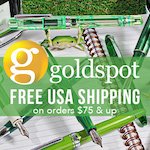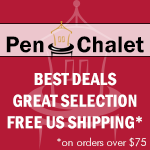This review is by Kalina Wilson, who can also be found at geminica.com.
The Zig CocoIro LetterPen is a fairly new product at JetPens, and I was immediately seduced by the brilliant color barrels and excited to see a variety of refill colors. However, each color was moving to "sold out" as I watched! In the end, what I received were this pretty, curvy yellow barrel with ink refills in black and royal blue.
(The pen bodies and refills appear to be mostly back in stock as of my writing.)
This pen has an unusual design. The refill is almost a pen in itself, with a solid cap that can be placed back on the refill allowing you to switch back and forth between in-use colors. The refill is not in itself very comfortable to hold, so it does needs the casing. When you insert the refill into the casing, the end sticks out the back so you can easily tell which color is currently in the pen.
I like the idea of this pen. It's in the style of the Tombow Fudenosuke and various fine-tipped Kuretake pens, in that it provides a very fine tip that offers some line variability.
However, while the body is cute and the refill color options alluring, this pen is not as strong as the Fudenosuke. The greatest fault is that the tip doesn't spring back after writing, so when you rotate the pen the next lines you draw are unpredictable. You might almost be able to see the slight bend in the uncapped tip in the above photo.
It's possible one could get used to the tip and take advantage of its variability - much in the way that you can cheat a finer line out of a fountain pen by turning the nib upside down. I ended up using the pen in this way for this drawing of a Victorian woman, but felt timid with it since whenever I rotated the pen to get a thinner line, it wasn't certain what kind of line would result.
It may take a close look, but you can see in this example that some of the lines came out weak or scratchy, or have a little glitch at the beginning as the tip bent into its new angle.
Subsequent water tests demonstrate that the ink is not even remotely waterproof.
A test with the royal blue refill yielded nothing special; the color is a bit ho-hum and the lines are not very smooth. The tip on this refill actually feels very dry.
While I like the physical appearance of the pen and was able to tease a couple of ok drawings out of it, there's simply nothing but appearance and some alternative ink colors to recommend it over the Tombow Fudenosuke which leaves a more pleasant, reliable, and waterproof mark.




